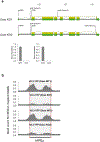On the role of H3.3 in retroviral silencing
- PMID: 28770848
- PMCID: PMC6258051
- DOI: 10.1038/nature23277
On the role of H3.3 in retroviral silencing
Conflict of interest statement
Figures





Comment on
-
Histone H3.3 is required for endogenous retroviral element silencing in embryonic stem cells.Nature. 2015 Jun 11;522(7555):240-244. doi: 10.1038/nature14345. Epub 2015 May 4. Nature. 2015. PMID: 25938714 Free PMC article.
-
Elsässer et al. reply.Nature. 2017 Aug 2;548(7665):E7-E9. doi: 10.1038/nature23278. Nature. 2017. PMID: 28770850 No abstract available.
References
Publication types
Grants and funding
LinkOut - more resources
Full Text Sources
Other Literature Sources
Molecular Biology Databases

